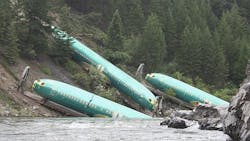Train derailment a cautionary tale for today's complicated aerospace manufacturing supply chain
Union commanders experienced this firsthand during the American Civil War 150 years ago when they tried to supply invading armies from supply depots located far back behind the lines. A quick confederate cavalry raid, and ... snip ... they had an Army group operating in hostile territory without a source of resupply for food, ammunition, and other necessities.
Today's high-tech aerospace manufacturing often involves procedures far more complicated even than military operations, and their long lines of supply can be just as vulnerable, as Boeing Commercial Airplanes experienced this past week.
Building a modern passenger jetliner is complicated and expensive. Boeing experts have found one of the quickest and cost-effective ways to do this is to have its contractor Spirit AeroSystems Holding Inc. build aircraft fuselages and other components in its factories in Wichita, Kan., and ship them by rail to the Seattle area for final assembly.
Related: RFID tracking brings new challenges to logistics
When this works, it works, but when it doesn't the results can be pretty spectacular.
Last Thursday a 19-car Montana Rail Link train transporting six fuselages for single-aisle Boeing 737 passenger jets, as well as fuselage panels for a long-range 777 jumbo jet and wing parts for a 747 jumbo jet, derailed near Rivulet, Mont., in mountainous country west of Missoula, and dumped three of the 737 fuselages into the nearby Clark Fork River.
According to news reports, a fourth 737 fuselage was torn apart during the train derailment. No word about the status of the other aircraft components. Suffice it to say this was a mess, not only for Montana Rail Link train operations, but also and especially for Boeing's commercial jet manufacturing process.
Related: Logistics for the transformational force
It's not clear if the fuselages can be salvaged and built into new airplanes. Come to think of it, I'm not sure I'd want to be a passenger on a plane that had been dumped down an embankment and into a river during manufacturing, but I digress.
By today the rail line is supposed to be re-opened for operation, and the unfortunate passenger jet fuselages plucked from the Clark Fork River and headed to their next destination.
It's all a cautionary tale about today's complicated logistics supply chains. Who ever dreamed that a mishap on a 35-mile-per-hour piece of railroad track in Western Montana could have such an impact on such a finely tuned manufacturing process?
Train derailments, undoubtedly, are playing into Boeing's planning now.
